Agriculture in PH: Barely surviving migration, conversion, poverty
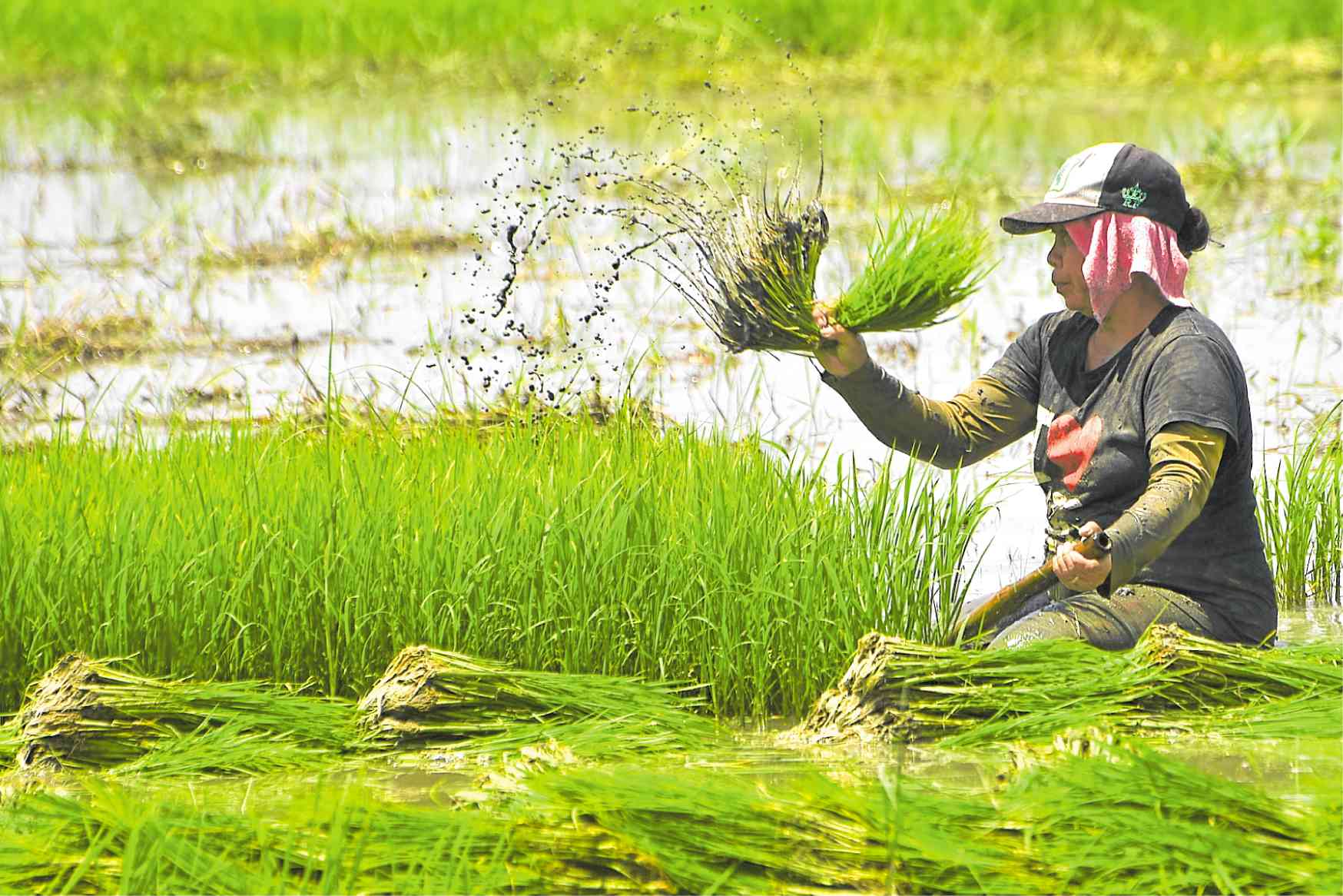
FARM-CENTRIC A farmer in Pangasinan province prepares for rice planting. Agriculture as a profession should appeal to young generations, according to Education Secretary Leonor Briones. File photo: Willie Lomibao
MANILA, Philippines — The month of June is coming to an end, so is the celebration of Rural Workers’ Month.
The celebration, which aims to give recognition to the hardship, sacrifices, and contribution of rural workers to the country’s economic development, was made official through Proclamation No. 2418 signed in 1985 by the late dictator Ferdinand Marcos.
The decree was passed 10 years after the International Labor Organization (ILO) ratified ILO Convention 141—which recognizes the importance of rural workers.
But decades after the declaration, rural workers continue to struggle with the same challenges, including fair compensation and land ownership.
The Food and Agricultural Organization (FAO), of the United Nations (UN), said there’s already a crisis in agriculture caused by decades of productivity decrease, high production costs and low government support. FAO cited a report by Canadian International Development Agency—Philippines-Canada Local Government Support Program (CIDA-LGSP).
Article continues after this advertisement“The general trends in the last two decades present a dim picture of the agriculture sector,” said the UN specialized agency.
Article continues after this advertisement“The neglect of the agriculture sector and the uneven distribution of resources worsened the poverty situation in rural areas,” said FAO.
“Only the remittances of migrant workers to their families have enabled the latter to survive crippling poverty brought about by stagnant agricultural productivity, stiff competition from cheaper food imports, and periodic droughts and floods that devastated crops and livelihoods,” it added.
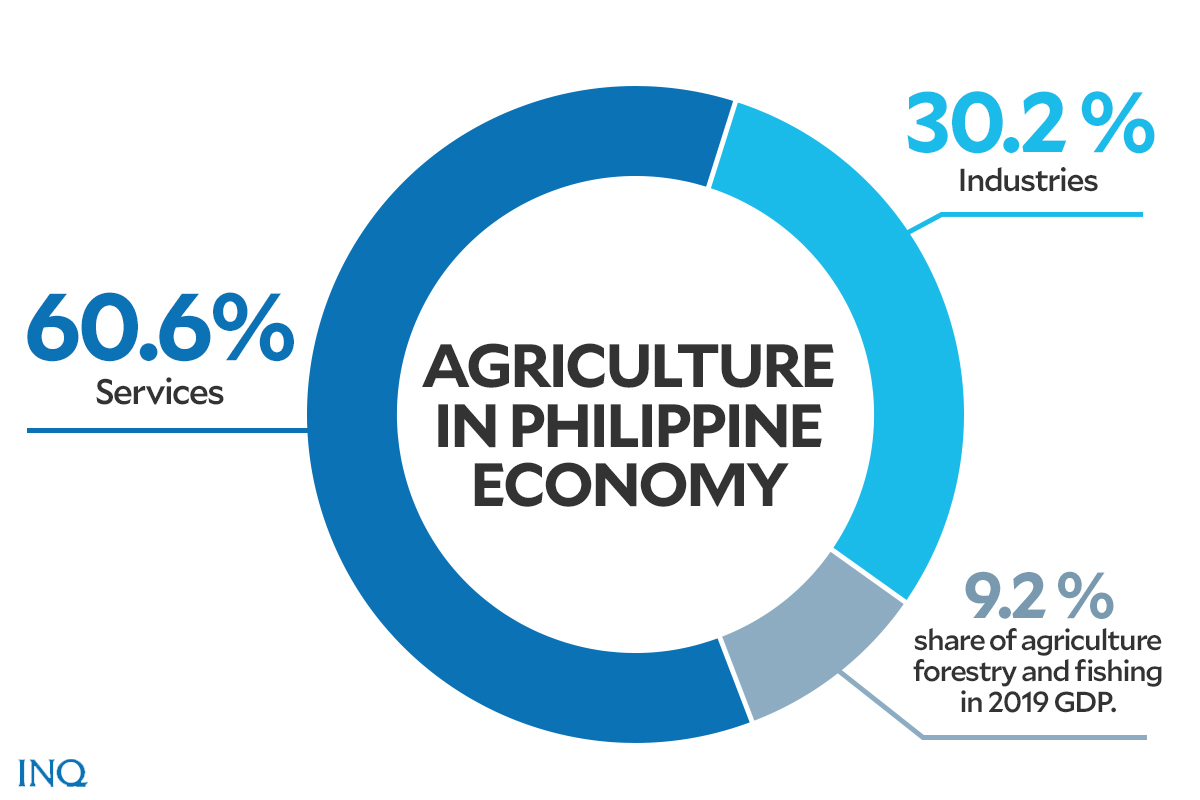
GRAPHIC BY ED LUSTAN
State of agriculture in PH economy
The Agricultural Indicators System report released by the Philippine Statistics Authority (PSA) in 2020 showed the share of the agriculture, forestry and fishing sector to the country’s gross domestic product (GDP) was just 9.2 percent.
The sector remained to be the lowest contributor among the three major sectors of the economy—industry (30.2 percent) and services (60.6 percent).
The PSA report noted a trend of decline in agriculture’s GDP share:
- 2015: services (58.8 percent), industry (30 percent), agriculture (11.3 percent)
- 2016: services (59.3 percent), industry (30.3 percent), agriculture (10.4 percent)
- 2017: services (59.6 percent), industry (30.3 percent), agriculture (10.1 percent)
- 2018: services (59.8 percent), industry (30.6 percent), agriculture (9.7 percent)
- 2019: services (60.6 percent), industry (30.2 percent), agriculture (9.2 percent)
Gross value added (GVA)—used to measure the performance of the sector—in agriculture, fisheries and forestry in 2019 prices was just P1.7 billion.
According to FAO, almost half of main agricultural enterprises are focused on crop cultivation. Chicken broiler production accounts for 20.4 percent, 19.8 for agricultural services and 18.4 percent for hog farming.
In terms of export value, agro-based products contributed $350.03 million to the $23.37 billion cumulative export earnings of the Philippines from January to April 2021, according to PSA.
The agriculture sector
Data from PSA’s Labor Force Survey (LFS) showed that the agriculture sector has seen several changes in terms of employment rate during the first four months of 2021.
In January, 24.4 percent, or 10,064,512 of the total 41,248,000 employed population in the country, was in agriculture. But as the number of employed individuals increased to 43,153,000 in February, the percentage of those in agriculture dropped to 23.9 percent or 10,313,567.
It improved to 24.6 percent in March as the employment rate reached 92.9 percent and the working population climbed to 45,332,000.
In April, out of the 43,269,000 employed persons, 24.4 percent or around 10,557,636 individuals remained in the agriculture sector.
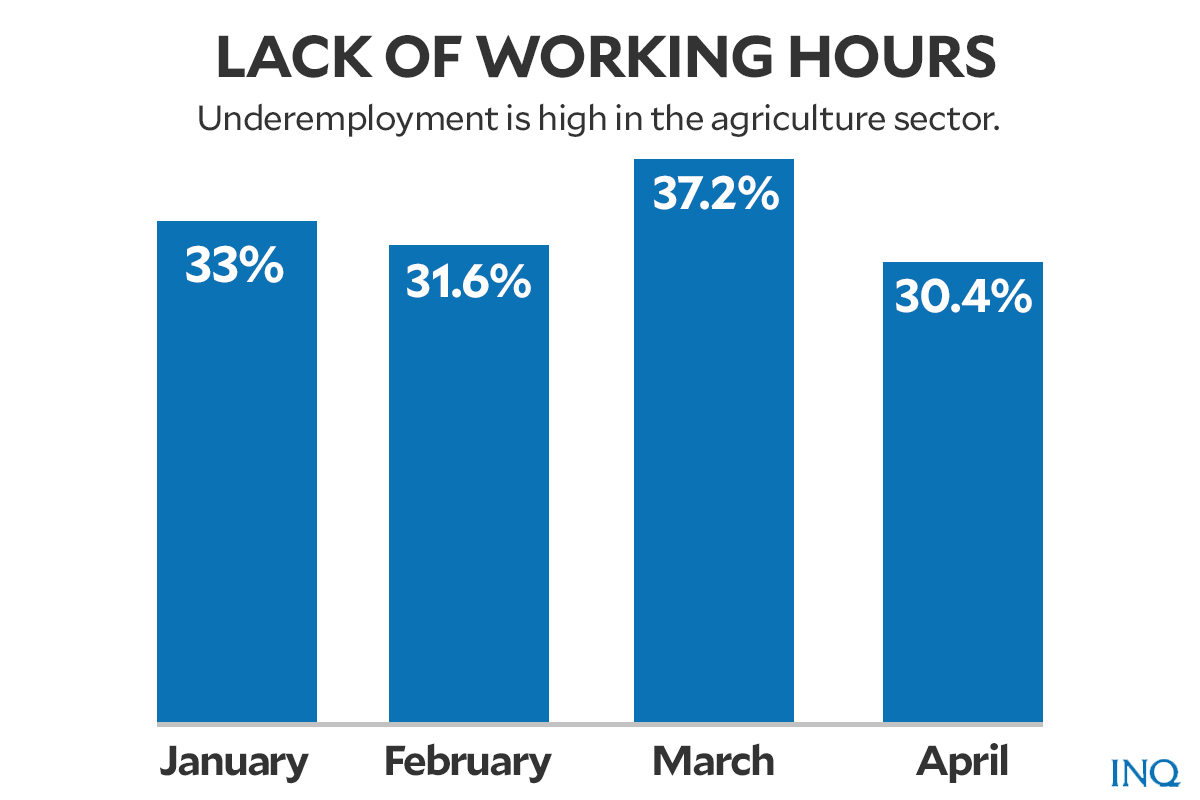
GRAPHIC BY ED LUSTAN
The year-on-year changes in the number of employed persons in the agriculture and fishery sub-sector from April 2020 to April 2021 was around 1.55 million—among the highest increase recorded among different sub-sectors.
But between January and March, the portion of underemployed persons in the agriculture sector kept increasing.
As defined by the central statistics authority, “employed persons who express the desire to have additional hours of work in their present job or an additional job, or to have a new job with longer working hours” are categorized as underemployed.
The percentage of underemployed persons in the agriculture sector were:
- January: 33 percent
- February: 31.6 percent
- March: 37.2 percent
- April: 30.4 percent
Migration
The 2018 National Migration Survey (NMS) by PSA and the UP Population Institute (PPI) reported that 55 percent of the country’s total population aged 15 and over has migrated either within the country (88 percent), outside the country (five percent), or both (seven percent).
An individual is considered to have migrated if he or she has moved residences and stayed there for at least three months.
The internal migration flow consists of 57 inter-regional, 13 percent inter-provincial, and 31 percent inter-municipality patterns.
The report noted that at least 699,000 from the Bicol region have migrated to the National Capital Region (NCR). At least 541,000 crossed regional boundaries from Western Visayas to NCR and 489,000 from Eastern Visayas to the country’s capital.
The 2018 NMS findings also found that rural to rural flow dominated the inter-migration flow in the country with around 49 percent. It is followed by rural to urban migration flow which accounted for 35 percent, urban to urban at around 13 percent, and urban to rural at five percent.
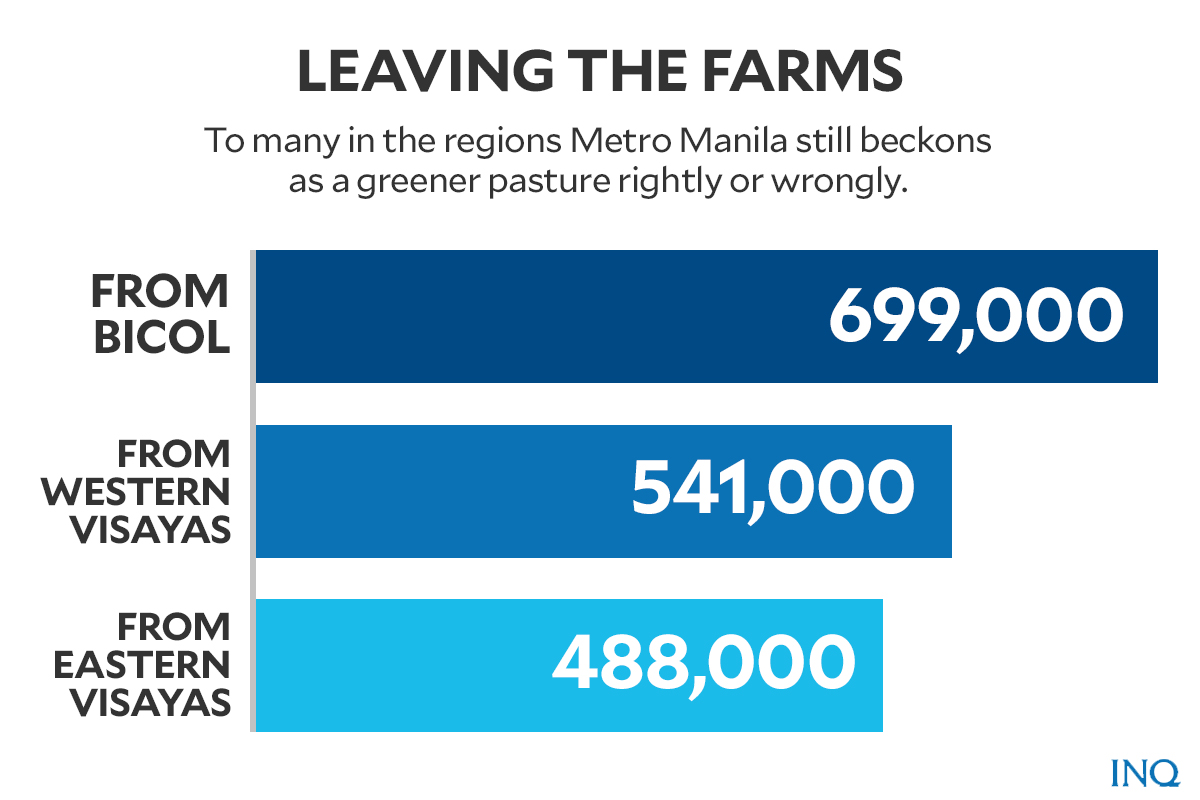
GRAPHIC BY ED LUSTAN
The PSA and UP PPI cited economic opportunities and work-related opportunities as among factors which contributed to the rising urban-rural population disparities in the country.
Several studies had detailed the impact of migration on the Philippine agriculture sector. These included Interrelations between Public Policies, Migration and Development in the Philippines report (IPPMD) of the Scalabrini Migration Center (SMC) and the OECD Development Centre, in collaboration with the Commission on Filipinos Overseas (CFO) and with support from the European Union.
Emigration, according to the report, decreases labor availability within the agricultural household and potentially in the wider community.
In certain instances, the departure of the most productive workers threatens the agriculture sector as it may lead to shortages and food insecurity in communities.
On the other hand, migration “can be a source of investment and innovation for the sector through remittances and social and financial capital brought home by return migrants.”
The remittances and financial capital may be used to invest in productive assets including machinery, barns, fencing, feeding mechanisms, irrigation systems, and tractors.
Another positive impact of migration is that remittances can help secure agricultural households against shortage of food and other challenges.
Emigration and labor in agricultural households
IPPMD likewise found that agricultural households with emigrant members seek and hire more external labor for agricultural activities—whether close friends or workers—to fill the labor gap.
“The departure of a household member may cause remaining family members to adjust their labour patterns,” the report said.
Migration by agriculture workers, the report added, “increases the probability that those remaining behind will have to work, unless remittances are received.”
According to data, households without emigrants outnumber households with emigrants in terms of household members working on the farm (0.8 vs 1.2).
The figure, according to the report, suggested that the percentage of households with emigrants employing workers to farm is higher at 63 percent compared to households without emigrants with 36 percent.
The data also found that the number of hired external workers was higher in households with emigrants (5.6) compared to the other households (5.0).
The numbers “suggest that households receiving remittances hire fewer external workers than households not receiving remittances.”
“This shows that while emigration may have little effect on how households deal with labor, remittances can reduce the need to hire more labor, perhaps because they allow the household to live on lower agricultural outputs or because remittances are used in other productive ways, perhaps more efficiently, thus reducing the need for labour,” the report concluded.
Farmlands owned
According to the 2012 Census of Agriculture and Fisheries (CAF), Philippines’ holders or farm operators manage around 5.6 million holdings to farms, covering at least 7.3 million hectares.
The largest holding, or farm area, was located in the Bicol Region—774,000 hectares.
Holders or farm operators in SOCCSKSARGEN, Davao Region, Northern Mindanao, and CALABARZON also had large holding or farm areas.
At least 99.1 percent—or 5.5 million holdings or farms covering 6.8 million hectares—in the Philippines is managed by individual proprietors including households or individual holders or farm operators.
Each individual proprietor had an average area of 1.2 hectares.
Corporate holdings or farms held an average area of 97.1 hectares while holdings or farms operated by cooperatives controlled 92.5 hectares average.
The PSA-led census also detailed that at least 46 percent of the country’s total holding or farm parcels were already fully owned by holders or farm operators.
“Across regions, the Cagayan Valley had the highest number of fully-owned holding/farm parcels located within its jurisdiction,” the PSA report said.
“These parcels covered 57 percent of the total holding/farm parcel areas in the Cagayan Valley with an average area of 0.6 hectares per parcel,” the report read.
“Among the regions in the Philippines, the Ilocos Region reported the highest number and proportion (240 thousand parcels or 40%) of tenanted parcels located within its vicinity. These parcels had an average area of 0.4 hectares,” it added.
During previous months, the DAR reported that hundreds of farmers have been granted land ownership after a wait of many years.
In March, 149 families received an 81.85-hectare government-awarded hacienda in Pili, Camarines Sur after a 27-year-ordeal against a private corporation.
In the same month, 249 agrarian reform beneficiaries (ARBs) from Capiz were awarded a total of 398 hectares of agricultural land.
The following month, DAR said 3,500 ARBs from SOCCSKSARGEN have also received their Certificate of Land Ownership Awards (CLOA) from the department.
Land conversions
While several parcels of farmland have already been given to some farmers, there are, unfortunately, portions of land that had been planned or already converted.
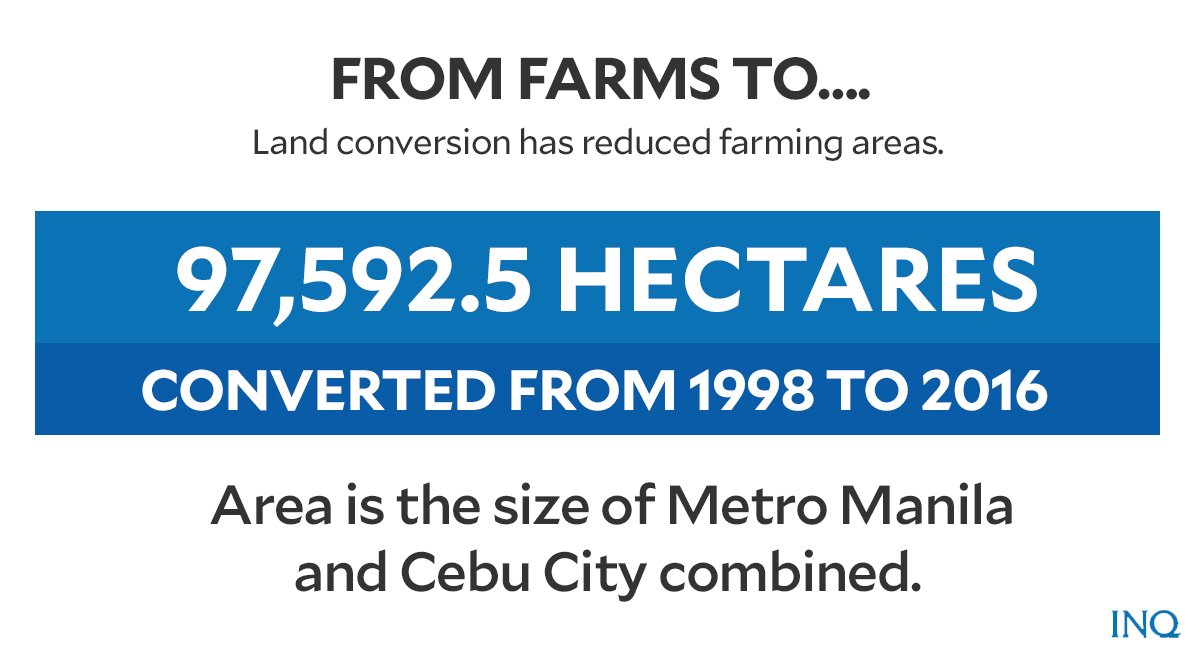
GRAPHIC BY ED LUSTAN
Based on data by the Department of Agriculture (DAR), a total of 97,592.5 hectares of agricultural land—the size of Metro Manila and Cebu City—were approved for conversion to non-agricultural purposes between 1998, the year when the Comprehensive Agrarian Reform Law took effect, and 2016.
Majority of the approved land conversion was located in CALABARZON with 26,739.03 hectares. It is followed by the 3,937.55 hectares in Central Luzon and 2,416.25 hectares in Western Visayas.
At least 1,652.69 hectares of agricultural land was set to be converted in Northern Mindanao, 1,411.20 hectares in SOCCSKSARGEN, and 4,152.12 hectares in other regions.
Batangas has a huge share of land set for conversion with 10,601.04 hectares. Cavite had 6,790.8 hectares, 5,744.3 hectares in Laguna, 1,936.6 hectares in Rizal, and 1,645.77 hectares in Quezon.
Outside the region, Bulacan registered 1,441.56 hectares of land while the remaining 12,151.78 hectares can be found in other provinces.
The approved conversion applications in DAR regional provinces consist of 80.6 percent land in Luzon, 7.8 percent in Visayas, and 11.6 percent in Mindanao.
Pending applications for conversion, agricultural land reclassified by the local government units, and illegally converted lands are, however, not included in the said figure.
READ: Many farms lost to land conversion
In 2019, Senator Kiko Pangilinan filed a bill that seeks to address unbridled land conversion by requiring additional certifications before developers can be granted a conversion permit.
Top crops
Of 21 major crops identified and highlighted in the Crops Statistics of the Philippines report published last year, palay was predominant.
It covered a combined area of 4.8 million hectares. This was over the 4.0 million hectares of land for palay in 1991.
Central Luzon had the highest proportion of total area planted with palay in the country at 15.7 percent. It is followed closely by Western Visayas at 13.5 percent and Cagayan Valley at 12.5 percent.
The next top crop under the category was corn, planted in 2.5 million hectares. Sugarcane ranked third with 379,200 hectares followed by cassava with 222,400 hectares and sweet potato with 83,300 hectares.
In terms of the highest volume of production, sugarcane ranked first with a total of 20,719,291.05 metric tons of yield in 2019.
Around 20,719,291.05 metric tons of rubber were meanwhile produced during the same year, 18,814,827.29 metric tons of palay, 14,765,057.06 metric tons of coconut with husk, 9,157,676.11 metric tons of banana, and 7,978,844.55 metric tons of corn.
Other crops including pineapple, cassava, sweet potato, and mango also had a high volume of production.
The list for top harvests in metric tons from fruit-bearing trees showed:
- Coconut: 347,952,192.00
- Banana: 285,335,123.00
- Coffee: 74,507,691.96
- Rubber: 57,805,744.12
- Mango: 9,560,248.00
- Calamansi: 8,329,453.00
- Oil palm: 6,870,233.00
- Cacao: 5,750,332.00
- Papya: 4,767,176.03
- Cashew: 3,732,694.00
- Lanzones: 1,993,141.00
- Durian: 1,342,881.00
On gender and wages
The 2012 CAF also reported that there were at least 5.6 million holders or farm operators aged 15 and over. The census also found that around 84 percent of the holders or farm operators were male while 16 percent were female.
“Usually, a female household member becomes a holder/farm operator in the absence of a male head or male household member. Hence, this explains the nil percentage of female holders/farm operators in the country,” the report said.
“The holders/farm operators in the country posted a median age of 47.2 years old. The male holders/farm operators had a median age of 46.3 years old, which was six years younger than their female counterparts,” it added.
In the country, there were at least 5.4 million households that had at least one member in agriculture as holder or farm operator.
Around 97 percent of the group said they have only one holder or farm operator while the rest of the households have two or more holders or operators managing their land.
In 2012, 8.6 million household members were reported to have engaged in agricultural activities, 7.4 million of which worked on their own farms, while 527,000 worked on a farm they did not own.
The PSA said that farmworkers are paid an average daily wage of P311.10 in 2019. In CALABARZON, it can shoot up to P399.08.
The wage offered in Central Visayas for farmworkers was, however, the lowest at P276.43.
The average daily nominal wage rates of farmworkers by region in 2019 included:
- Philippines: P331.10
- CAR: P304.83
- Ilocos Region: P354.65
- Cagayan Valley: P352.76
- Central Luzon: P353.12
- CALABARZON: P399.08
- MIMAROPA: P394.27
- Bicol Region: P334.27
- Western Visayas: P305.83
- Central Visayas: P276.43
- Eastern Visayas: P309.36
- Zamboanga Peninsula: P280.39
- Northern Mindanao: P280.73
- Davao Region: P329.71
- SOCCSKARGEN: P297.60
- Caraga: P342.23
- BARMM: P296.84
Wage distribution by gender of farmworkers likewise favored males. Male farm workers can receive up to P335 salary per day while women farmworkers will only get P304.60.
However, in Davao Region, female farmworkers are given P37.64 more in daily salary than men.
The PSA also noted that workers in palay farms get a higher wage rate of P351.39 per day compared to corn farm laborers who receive at least P288.04 daily and workers in coconut and sugarcane farms who are given an average payment of P338.72 and P309.08 respectively.